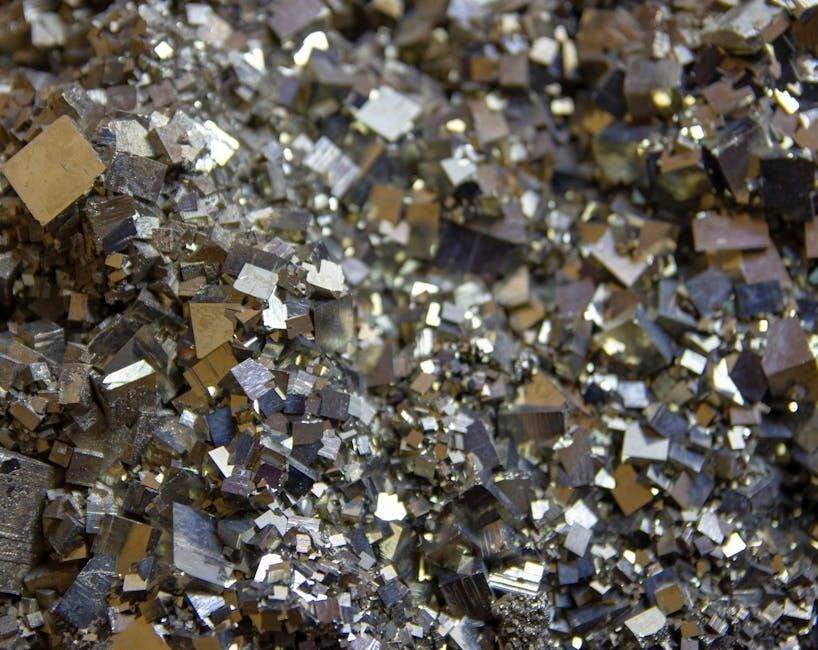Gold-bearing rocks are geological formations containing gold in economic concentrations, shaped by magmatic, metamorphic, or sedimentary processes. Understanding their characteristics is vital for exploration and mining, as gold’s unique properties make it a highly sought-after resource. These rocks often exhibit distinct physical features and mineral associations, such as quartz veins or hydrothermal alterations, which aid in identification. The study of gold-bearing rocks is crucial for uncovering their formation mechanisms and exploiting their economic potential effectively.
1.1 Importance of Gold-Bearing Rocks in Geology
Gold-bearing rocks hold significant geological importance as they provide insights into Earth’s tectonic history and the processes driving mineral formation. These rocks often serve as indicators of hydrothermal activity, tectonic movements, and ancient geological events. Their study helps geologists understand the distribution of valuable minerals and the conditions necessary for economic deposits to form. Additionally, gold-bearing rocks act as natural laboratories for studying geochemical processes, offering clues about the Earth’s crustal evolution. By analyzing these rocks, scientists can reconstruct ancient environments, trace fluid flow patterns, and identify areas of potential mineral wealth. Thus, their study is not only economically valuable but also crucial for advancing geological knowledge and exploration techniques.
1.2 Economic Significance of Gold-Bearing Rocks
Gold-bearing rocks are of immense economic value, driving mining industries worldwide. The extraction of gold from these rocks supports global markets, jewelry production, and financial reserves. Their economic significance is further enhanced by their association with other valuable minerals, often found alongside gold, which adds to their resource potential. Additionally, advancements in mining technologies have improved the efficiency of extracting gold from complex rock formations, making once-marginal deposits economically viable. The revenue generated from gold-bearing rocks contributes to national economies and sustains local communities reliant on mining activities. As a result, these rocks remain a cornerstone of the global mineral economy, underpinning both industrial and monetary systems.
Types of Gold-Bearing Rocks
Gold-bearing rocks include igneous, metamorphic, and sedimentary types. Igneous rocks, like granites, host gold in quartz veins. Metamorphic rocks, such as schists, contain gold in altered zones. Sedimentary rocks, including conglomerates, may hold placer gold deposits. Each type has unique characteristics influencing gold concentration and extraction methods.
2.1 Igneous Rocks
Igneous rocks, formed from cooled magma, often host gold deposits. Granite batholiths are key sources, with gold concentrated in quartz veins. Porphyry deposits, like those in Nevada, show high-grade mineralization. Magma differentiation enriches gold in specific zones. Hydrothermal activity alters these rocks, creating silicification and argillic changes. SEM-EDS analysis reveals gold’s presence in sulfide minerals. Igneous rocks’ structure and alteration patterns guide exploration. Understanding their genesis aids in targeting gold-rich areas effectively, enhancing mining success rates and economic returns from these valuable geological formations.
2.2 Metamorphic Rocks
Metamorphic rocks, transformed under high pressure and temperature, often host gold deposits. Marble, schist, and gneiss are common hosts, with gold concentrated in quartz veins or disseminated within altered zones. Skarn deposits, formed from limestone alteration, are prominent in areas like Nevada. Hydrothermal fluids enrich these rocks with gold, often accompanied by sulfide minerals like pyrite and arsenopyrite. Structural features such as faults and folds create pathways for mineralizing fluids. Advanced techniques like SEM-EDS and XRD are essential for identifying gold-bearing phases. Understanding the interplay of metamorphism and hydrothermal activity is crucial for exploring these deposits, as they provide valuable insights into gold distribution and extraction potential.
2.3 Sedimentary Rocks
Sedimentary rocks, formed by erosion and deposition, can also contain gold, particularly in conglomerates, sandstones, and shales. These deposits often result from ancient placer activities, where gold accumulates in fluvial or marine environments. Quartz-pebble conglomerates, like those in South Africa’s Witwatersrand Basin, are renowned for their gold content. In some cases, gold is associated with sulfide minerals such as pyrite, making identification challenging without advanced techniques. The unique properties of gold, such as its high density, allow it to concentrate in specific sedimentary layers. Understanding the geological history and depositional environments of these rocks is essential for effective exploration and extraction of gold-bearing sedimentary formations.

Geological Formations Associated with Gold
Gold is often found in quartz veins, skarn deposits, and hydrothermal veins, which are key geological formations linked to its mineralization. These formations provide critical insights into gold’s origin and concentration, aiding in exploration and extraction efforts.
3.1 Quartz Veins
Quartz veins are prominent geological structures often associated with gold mineralization. These veins, typically formed in fractures or fault zones, consist of quartz and other minerals. Gold commonly occurs within these veins due to hydrothermal activity, where mineral-rich fluids deposit gold and quartz. The presence of sulfide minerals like pyrite and arsenopyrite often accompanies gold in these veins. Field studies and PDF guides emphasize that quartz veins can vary in thickness and orientation, with gold distribution influenced by the vein’s geological setting. Identifying quartz veins requires understanding their textural features and mineral associations, making them a critical target in gold exploration efforts worldwide.
3.2 Skarn Deposits
Skarn deposits are metamorphic rocks formed through the interaction of magmatic fluids with carbonate-rich host rocks, often near granitic intrusions. These deposits are significant for hosting gold and other metals. Skarns typically exhibit zonation, with minerals like garnet, pyroxene, and epidote dominating. Gold in skarns is often associated with sulfide minerals such as pyrite, chalcopyrite, and arsenopyrite. The Wadi Allaqi area in Egypt is a notable example, where gold-bearing skarns are linked to ophiolitic fragments and intrusive rocks. High sulfidation assemblages in these deposits indicate a strong hydrothermal influence. Skarn deposits are economically important, and their study is crucial for understanding gold mineralization in metamorphic settings, as detailed in gold-bearing rock identification PDF guides.
3.3 Hydrothermal Veins
Hydrothermal veins are primary conduits for gold mineralization, formed by hot, mineral-rich fluids circulating through fractures in rocks. These veins often consist of quartz and various sulfide minerals like pyrite and arsenopyrite, which are indicators of gold presence. The formation of hydrothermal veins is closely linked to intrusive rocks and areas of significant tectonic activity. They can occur in igneous, metamorphic, or sedimentary settings and are a key target in gold exploration. Veins vary in thickness and continuity, with gold distribution often being erratic. Advanced techniques like SEM-EDS analysis are employed to study the mineralogical composition of these veins, aiding in the identification of gold-bearing zones, as outlined in detailed gold-bearing rock identification PDF guides.

Identification Techniques for Gold-Bearing Rocks
Identification involves examining physical characteristics, mineral associations, and geological mapping. Techniques include visual inspection for quartz veins and sulfides, aiding in locating gold-bearing formations, as detailed in guides.
4.1 Physical Characteristics
Gold-bearing rocks often exhibit distinct physical characteristics that aid in their identification. These include the presence of quartz veins, which are commonly associated with gold deposits. The veins may appear as white or translucent streaks within the host rock and can be accompanied by sulfide minerals like pyrite or arsenopyrite. Additionally, hydrothermal alteration zones, such as silicification or argillic alteration, are often visible, indicating potential gold mineralization. The texture of the rock can also provide clues; for instance, porous or vuggy textures may suggest the presence of hydrothermal activity. By carefully examining these physical traits, prospectors and geologists can narrow down areas of interest and improve the efficiency of their exploration efforts.
4.2 Mineral Associations
Gold-bearing rocks are frequently associated with specific minerals that serve as indicators of potential gold deposits. Commonly, gold is found alongside sulfide minerals such as pyrite, chalcopyrite, and arsenopyrite, which are often concentrated in hydrothermal veins. Quartz is a prominent mineral in many gold-bearing formations, forming veins that act as conduits for gold mineralization. Additionally, minerals like galena, sphalerite, and stibnite may also be present, particularly in polymetallic deposits. The presence of these minerals can help prospectors and geologists identify areas with a higher likelihood of gold occurrence. Understanding these mineral associations is crucial for effective exploration and for distinguishing between barren and gold-bearing rocks in the field.
4.3 Geological Mapping
Geological mapping is a fundamental tool for identifying gold-bearing rocks, as it provides detailed insights into the distribution of rock types, structural features, and mineralized zones. By systematically studying the geological setting, researchers can pinpoint areas with potential gold deposits. Mapping techniques often involve analyzing alteration patterns, fractures, and vein systems, which are commonly associated with gold mineralization. Hydrothermal alteration zones, for instance, are key indicators of gold-bearing rock formations. Geological maps also help in understanding the regional geology and tectonic framework, which are critical for targeting exploration efforts. Additionally, mapping aids in visualizing the spatial relationships between different rock units, facilitating the identification of prospective areas for further investigation. This method is essential for both amateur prospectors and professional geologists seeking to locate gold-bearing rocks effectively.

Role of Hydrothermal Alteration
Hydrothermal alteration plays a crucial role in forming gold-bearing rocks by transforming existing rock types through interactions with hot, mineral-rich fluids. This process creates quartz veins and sulfide minerals, key indicators of gold deposits, aiding in their identification and exploration.
5.1 Silicification

Silicification is a key hydrothermal alteration process where silica-rich fluids replace original rock minerals, creating quartz veins and enriching gold concentrations. This process is often linked to epithermal and mesothermal gold deposits. Silicified zones are resistant to weathering, making them visible markers for prospecting. The formation of quartz veins within these zones is a strong indicator of gold mineralization, as gold often precipitates alongside quartz. In gold-bearing rocks, silicification alters the host rock’s texture and mineral composition, enhancing the visibility of gold-bearing structures. This alteration is critical for identifying potential gold deposits, as it provides clear geological signatures that guide exploration and mining efforts effectively.

5.2 Argillic Alteration
Argillic alteration is a hydrothermal process that converts primary minerals into clay minerals, commonly in the upper levels of gold-bearing systems. This alteration is typically associated with acidic fluids and occurs at shallower depths compared to silicification. In gold-bearing rocks, argillic alteration can lead to the formation of kaolinite, montmorillonite, and other clay minerals, which are often indicators of gold mineralization. The alteration weakens the rock structure, making it more susceptible to weathering and erosion. Recognition of argillic zones is crucial for gold exploration, as they often overlie or are adjacent to gold deposits. This alteration type is particularly significant in epithermal gold systems, where its presence aids in pinpointing potential gold-bearing areas for further investigation and extraction.

Advanced Analytical Methods
Advanced techniques like SEM-EDS and X-Ray Diffraction (XRD) provide detailed mineralogical insights, aiding in the precise identification of gold-bearing rocks and their elemental composition.
6.1 SEM-EDS Analysis
SEM-EDS analysis is a powerful tool for identifying gold-bearing rocks by examining their mineral composition and elemental distribution. Scanning Electron Microscopy (SEM) provides high-resolution images of rock surfaces, while Energy-Dispersive X-Ray Spectroscopy (EDS) identifies the elemental makeup of minerals. This technique is particularly useful for detecting gold and associated minerals like pyrite, quartz, and sulfides. SEM-EDS can also reveal subtle textures and alterations, such as silicification or argillic changes, which are critical for understanding gold-bearing rock formation. By analyzing these features, geologists can better identify prospective gold deposits and distinguish them from barren rocks. This method is especially valuable for complex or weathered samples where physical characteristics are less discernible, making it a cornerstone in modern geological research and exploration.
6.2 X-Ray Diffraction (XRD)
X-Ray Diffraction (XRD) is a non-destructive analytical technique used to identify the mineralogical composition of gold-bearing rocks. By analyzing the diffraction patterns of X-rays scattered by the rock’s crystal structures, XRD determines the presence of specific minerals. This method is particularly effective for identifying quartz, sulfides, and other minerals commonly associated with gold deposits. XRD also helps detect hydrothermal alteration products, such as silicates and oxides, which are often linked to gold mineralization. Combined with SEM-EDS, XRD provides a comprehensive understanding of the mineral associations and geological context of gold-bearing rocks. Its ability to automate mineral identification makes it a valuable tool for prospecting and understanding the mineralogy of complex rock samples, enhancing the accuracy of gold deposit exploration and characterization.
Case Studies of Gold-Bearing Rock Deposits
Case studies reveal gold deposits in diverse geological settings, including Nevada’s skarns and Wadi Allaqi’s ophiolitic fragments. These examples highlight quartz veins, hydrothermal alterations, and mineral associations critical for identification and exploration, showcasing the complexity of gold-bearing rock formations across different regions.
7.1 Nevada Deposits
Nevada is renowned for its rich gold deposits, particularly in the Carlin Trend and Battle Mountain districts. These deposits are often associated with skarns and hydrothermally altered rocks, where gold is found in quartz veins and sulfide minerals like pyrite. The state’s unique geology, including granitic intrusions and volcanic activity, has created fertile ground for gold mineralization. Detailed studies highlight the importance of silicification and argillic alteration in concentrating gold. Mineral associations, such as enargite and chalcopyrite, are common in these deposits, aiding in their identification. Nevada’s gold-bearing rocks are a prime example of how geological processes can create economically significant mineralized zones, making them a focal point for both research and mining operations.
7.2 Wadi Allaqi Area
The Wadi Allaqi area, located in Egypt, is known for its significant gold deposits, particularly in the context of ancient and modern mining activities. Geological studies indicate that the region’s gold-bearing rocks are associated with ophiolitic fragments, metamorphosed sequences, and intrusive rocks. The area’s proximity to the Nile River and its unique tectonic setting create a favorable environment for gold mineralization. Mineral associations, including sulfides and quartz veins, are key indicators of gold-bearing rocks in this region. Hydrothermal alteration and silicification are prominent features, aiding in the identification of potential gold deposits. The Wadi Allaqi area exemplifies how geological processes in suture zones can lead to the formation of economically valuable gold-bearing rock formations.
Industry Applications and Mining Techniques
Open-pit and underground mining are primary methods for extracting gold-bearing rocks. Open-pit mining is used for shallow deposits, while underground methods access deeper gold veins.
8.1 Open-Pit Mining

Open-pit mining is a surface mining method used to extract gold-bearing rocks from shallow deposits. It involves removing overburden, the soil and rock covering the ore, to access gold-bearing formations. This technique is cost-effective for large, near-surface deposits and offers higher recovery rates compared to underground mining. Open-pit mines are typically operated until the deposit is depleted or becomes too deep to remain economical. Environmental considerations, such as land restoration and water management, are critical components of modern open-pit mining operations. Advances in technology have improved efficiency and reduced the environmental impact of this method, making it a preferred choice for many gold mining projects worldwide.
8.2 Underground Mining
Underground mining is employed to extract gold-bearing rocks when deposits are deeper or not accessible via open-pit methods. This technique involves tunneling into the earth to reach gold-bearing veins or ore bodies. It is more complex and costly than open-pit mining due to the need for advanced equipment and infrastructure, such as shafts, tunnels, and ventilation systems. Underground mining methods include room-and-pillar, sublevel caving, and cut-and-fill, each suited to different deposit geometries and conditions. Despite its challenges, underground mining allows access to high-grade gold deposits that would otherwise remain untapped. Environmental and safety considerations, such as managing waste rock and ensuring stable tunnel structures, are critical to responsible underground mining operations. Advances in technology have improved efficiency and reduced risks in this specialized field.
Resources and References

Gold-bearing rock identification guides, academic papers, and research citations provide essential insights. Works by Theodore, Ramadan, and Hagemann offer detailed mineralogical and geological analyses. PDF resources are widely available.
9.1 Gold-Bearing Rock Identification PDF Guides
Gold-bearing rock identification PDF guides provide comprehensive insights into recognizing and analyzing gold-bearing formations. These resources often include detailed descriptions of physical characteristics, such as quartz veins, hydrothermal alterations, and mineral associations. Many guides are based on academic research, citing works by experts like Theodore, Ramadan, and Hagemann. They offer practical tips for distinguishing gold-bearing rocks from barren ones, emphasizing features like silicification and argillic alteration. Some PDFs include high-resolution images and geological maps to aid visual identification. These documents are invaluable for geologists, prospectors, and enthusiasts, serving as a bridge between theoretical knowledge and field applications. They are widely accessible online, making them a key resource for anyone exploring gold-bearing rock formations.
9.2 Academic Research and Citations
Academic research and citations are fundamental to advancing the understanding of gold-bearing rocks. Studies by T.G. Theodore (1991) and T.M. Ramadan (2001) provide detailed insights into mineral abundances and geological settings. S.G. Hagemann’s work (1998) offers a classification system for orogenic gold deposits. These studies highlight the importance of hydrothermal alteration and quartz veins in gold mineralization. Citations from F. Robert and J.J. Norton further explore mineral associations and structural controls. Academic research serves as the backbone for identifying gold-bearing rocks, offering methodologies and data critical for both exploration and mining. These works are extensively referenced in field guides and PDF resources, ensuring their findings are accessible to a broader audience. They remain essential for advancing prospecting and extraction techniques in geology.